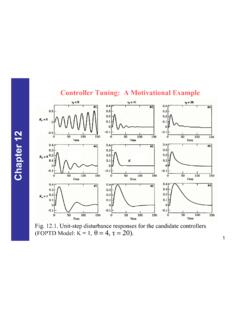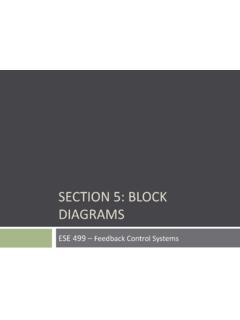Transcription of Control of Multiple-Input, Multiple- Output (MIMO) Processes
1 Control of Multiple- Input, Multiple- Output (MIMO) Processes Chapter 18. Process Interactions and Control Loop Interactions Pairing of Controlled and Manipulated Variables Singular Value Analysis Tuning of Multiloop PID Control Systems Decoupling and Multivariable Control Strategies Strategies for Reducing Control Loop Interactions 1. Control of Multivariable Processes In practical Control problems there typically are a number of process variables which must be controlled Chapter 18. and a number which can be manipulated. Example: product quality and throughput must usually be controlled. Several simple physical examples are shown in Fig. Note the "process interactions" between controlled and manipulated variables. 2. Chapter 18. SEE FIGURE in text.
2 3. Chapter 18. 4. Controlled Variables: xD , xB , P, hD , and hB. Manipulated Variables: D, B, R, QD , and QB. Note: Possible multiloop Control strategies = 5! = 120. Chapter 18. 5. In this chapter we will be concerned with characterizing process interactions and selecting an appropriate multiloop Control configuration. If process interactions are significant, even the best multiloop Control system may not provide satisfactory Control . Chapter 18. In these situations there are incentives for considering multivariable Control strategies. Definitions: Multiloop Control : Each manipulated variable depends on only a single controlled variable, , a set of conventional feedback controllers. Multivariable Control : Each manipulated variable can depend on two or more of the controlled variables.
3 Examples: decoupling Control , model predictive Control 6. Multiloop Control Strategy Typical industrial approach Consists of using n standard FB controllers ( , PID), one for each controlled variable. Control system design Chapter 18. 1. Select controlled and manipulated variables. 2. Select pairing of controlled and manipulated variables. 3. Specify types of FB controllers. Example: 2 x 2 system Two possible controller pairings: U1 with Y1, U2 with Y2 (1-1/2-2 pairing). or U1 with Y2, U2 with Y1 (1-2/2-1 pairing). Note: For n x n system, n! possible pairing configurations. 7. transfer Function Model (2 x 2 system). Two controlled variables and two manipulated variables (4 transfer functions required). Chapter 18. Y1( s ) Y1( s ). = GP11( s ), = GP12 ( s ).
4 U1 ( s ) U2( s ). (18 1). Y2 ( s ) Y2 ( s ). = GP 21( s ), = GP 22 ( s ). U1 ( s ) U2( s ). Thus, the input- Output relations for the process can be written as: Y1( s ) = GP11( s )U1( s ) + GP12 ( s )U 2 ( s ) (18 2 ). Y2 ( s ) = GP 21( s )U1( s ) + GP 22 ( s )U 2 ( s ) (18 3). 8. Or in vector-matrix notation as, Y ( s ) = G p ( s )U ( s ) (18 4). Chapter 18. where Y(s) and U(s) are vectors, Y1 ( s ) U1 ( s ) . Y(s )= U( s ) = (18 5). Y. 2 ( s ) U. 2 ( s ) . And Gp(s) is the transfer function matrix for the process GP11( s ) GP12 ( s ) . G p( s ) = . G ( s ) G ( s ). (18 6). P 21 P 22 . 9. Chapter 18. 10. Control -loop Interactions Process interactions may induce undesirable Chapter 18. interactions between two or more Control loops. Example: 2 x 2 system Control loop interactions are due to the presence of a third feedback loop.
5 Problems arising from Control loop interactions i. Closed-loop system may become destabilized. ii. Controller tuning becomes more difficult. 11. Chapter 18. 12. Chapter 18. 13. block Diagram Analysis For the multiloop Control configuration, the transfer function between a controlled and a manipulated variable Chapter 18. depends on whether the other feedback Control loops are open or closed. Example: 2 x 2 system, 1-1/2 -2 pairing From block diagram algebra we can show Y1( s ). = GP11( s ), (second loop open) (18-7). U1( s ). Y1( s ) GP12GP 21GC 2. = GP11 (second loop closed) (18-11). U1( s ) 1 + GC 2GP 22. Note that the last expression contains GC2. 14. Chapter 18. 15. Chapter 18. 16. Chapter 18. 17. Chapter 18. 18. Relative Gain Array Provides two types of useful information: Chapter 18.
6 1. Measure of process interactions 2. Recommendation about best pairing of controlled and manipulated variables. Requires knowledge of steady-state gains but not process dynamics. 19. Example of RGA Analysis: 2 x 2 system Steady-state process model, y1 = K11u1 + K12u2. Chapter 18. y2 = K 21u1 + K 22u2. The RGA, , is defined as: 11 12 . = .. 21 22 . where the relative gain, ij, relates the ith controlled variable and the jth manipulated variable ( yi / u j )u open-loop gain ij = (18 24 ). ( yi / u j ) y closed-loop gain 20. Scaling Properties: i. ij is dimensionless ii. = . ij ij = Chapter 18. i j For a 2 x 2 system, 1. 11 = , 12 = 1 11 = 21 (18-34). K12 K 21. 1 . K11K 22. Recommended Controller Pairing It corresponds to the ij which have the largest positive values that are closest to one.
7 21. In general: 1. Pairings which correspond to negative pairings should not be selected. 2. Otherwise, choose the pairing which has ij closest to one. Examples: Chapter 18. Process Gain Relative Gain Matrix, K : Array, : K11 0 1 0 . 0. K 22 . 0 1 .. 0 K12 . 0 1 . K. 21 0 1 0 .. K11. 0. K12 . K 22 . 1 0 . 0 1 .. K11.. 0 . K 1 0 . 21 K 22 0 1 . 22. For 2 x 2 systems: 1. y1 = K11u1 + K12u2 11 =. K12 K 21. , 12 = 1 11 = 21. 1 . y2 = K 21u1 + K 22u2 K11K 22. Example 1: Chapter 18. K11 K12 2 . K = =. K 21 K 22 2 .. Recommended pairing is Y1. = and U1, Y2 and U2. 1. 29 2 .29 . Example 2: 2 . K = = . 2 0 .36 0. 64 .. Recommended pairing is Y1 with U1 and Y2 with U2. 23. Chapter 18 EXAMPLE: Thermal Mixing System The RGA can be expressed in two equivalent forms: Wh Wc Wh Wc T Tc Th T Wc Wh.
8 W W . Th Tc Th Tc Wc + Wh Wc + Wh . K= and = . Th T T Tc Wh Wc . T T . Th Tc Th Tc Wc + Wh Wc + Wh . Note that each relative gain is between 0 and 1. The recommended controller pairing depends on nominal values of T, Th, and Tc. 24. RGA for Higher-Order Systems For and n x n system, u1 u2 " un y1 11 12 " 1n . y2 21 22 " 2 n . = (18 25). Chapter 18. # # # % # .. yn n1 n1 " nn . Each ij can be calculated from the relation, ij = Kij H ij (18 37 ). where Kij is the (i,j) -element of the steady-state gain K matrix, y = Ku Hij is the (i,j) -element of the H = K ( ). -1 T. Note : KH. Example: Hydrocracker The RGA for a hydrocracker has been reported as, Chapter 18. u1 u2 u3 u4. y1 . y2 . = . y3 .. y4 . Recommended controller pairing? 26. Singular Value Analysis Any real m x n matrix can be factored as, T.
9 K=W V. Matrix is a diagonal matrix of singular values: = diag ( 1, 2, , r). Chapter 18. The singular values are the positive square roots of the T T. eigenvalues of K K ( r = the rank of K K). The columns of matrices W and V are orthonormal. Thus, T T. WW = I and VV = I. Can calculate , W, and V using MATLAB command, svd. Condition number (CN) is defined to be the ratio of the largest to the smallest singular value, 1. CN . r A large value of CN indicates that K is ill-conditioned. 27. Condition Number CN is a measure of sensitivity of the matrix properties to changes in individual elements. Consider the RGA for a 2x2 process, Chapter 18. 1 0 . K = = I. 10 1 . If K12 changes from 0 to , then K becomes a singular matrix, which corresponds to a process that is difficult to Control .
10 RGA and SVA used together can indicate whether a process is easy (or difficult) to Control . 0 . (K ) = CN = 101. 0 . K is poorly conditioned when CN is a large number ( , > 10). Thus small changes in the model for this 28. process can make it very difficult to Control . Selection of Inputs and Outputs Arrange the singular values in order of largest to smallest and look for any i/ i-1 > 10; then one or more inputs (or outputs) can be deleted. Chapter 18. Delete one row and one column of K at a time and evaluate the properties of the reduced gain matrix. Example: 0 .4 8 0 .9 0 0 .0 0 6 . K = 0 .5 2 0 .9 5 0 .0 0 8 . 0 .9 0 0 .9 5 0 .0 2 0 . 29.. W = .. 0 0 . = 0 0 V = . 0 0 . 18. Chapter18.. CN = ( 1/ 3). Chapter The RGA is: . = .. Preliminary pairing: y1-u2, y2-u3, y3-u1.


